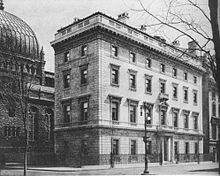
John William Sterling was a founding partner of Shearman & Sterling LLP and major benefactor to Yale University.

John Davison Rockefeller Jr. was an American financier and philanthropist. Rockefeller was the fifth child and only son of Standard Oil co-founder John D. Rockefeller. He was involved in the development of the vast office complex in Midtown Manhattan known as Rockefeller Center, making him one of the largest real estate holders in the city. Towards the end of his life, he was famous for his philanthropy, donating over $500 million to a wide variety of different causes, including educational establishments. Among his projects was the reconstruction of Colonial Williamsburg in Virginia. He was widely blamed for having orchestrated the Ludlow Massacre and other offenses during the Colorado Coalfield War. Rockefeller was the father of six children: Abby, John III, Nelson, Laurance, Winthrop, and David.
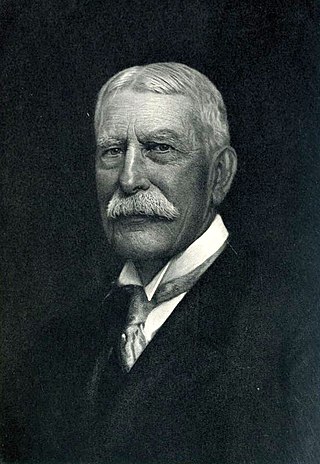
Henry Morrison Flagler was an American industrialist and a founder of Standard Oil, which was first based in Ohio. He was also a key figure in the development of the Atlantic coast of Florida and founder of the Florida East Coast Railway. He is also known as a co-founder and major investor of the cities of Miami and Palm Beach, Florida.
The Rockefeller family is an American industrial, political, and banking family that owns one of the world's largest fortunes. The fortune was made in the American petroleum industry during the late 19th and early 20th centuries by brothers John D. Rockefeller and William A. Rockefeller Jr., primarily through Standard Oil. The family had a long association with, and control of, Chase Manhattan Bank. By 1987, the Rockefellers were considered one of the most powerful families in American history. The Rockefeller family originated in Rhineland in Germany and family members moved to the Americas in the early 18th century, while through Eliza Davison, with family roots in Middlesex County, New Jersey, John D. Rockefeller and William A. Rockefeller Jr. and their descendants are also of Scots-Irish ancestry.

David Rockefeller was an American economist and investment banker who served as chairman and chief executive of Chase Manhattan Corporation. He was the oldest living member of the third generation of the Rockefeller family, and family patriarch from 2004 until his death in 2017. Rockefeller was the fifth son and youngest child of John D. Rockefeller Jr. and Abby Aldrich Rockefeller, and a grandson of John D. Rockefeller and Laura Spelman Rockefeller.
The Commonwealth Fund is a private American foundation whose stated purpose is to "promote a high-performing health care system that achieves better access, improved quality, and greater efficiency, particularly for society's most vulnerable, including low-income people, the uninsured, and people of color." It is active in a number of areas related to health care and health policy. It is led by Joseph R. Betancourt, M.D., M.P.H.

The Columbia University College of Physicians and Surgeons is the medical school of Columbia University, located at the Columbia University Irving Medical Center in the Washington Heights neighborhood of Manhattan.

James Gamble Rogers was an American architect. A proponent of what came to be known as Collegiate Gothic architecture, he is best known for his academic commissions at Yale University, Columbia University, Northwestern University, and elsewhere.
Anna Maria Richardson Harkness was an American philanthropist.

Stephen Vanderburgh Harkness was an American businessman based in Cleveland, Ohio. He invested as a silent partner with John D. Rockefeller, Sr. in the founding of Standard Oil and served as a director of Standard Oil until his death.
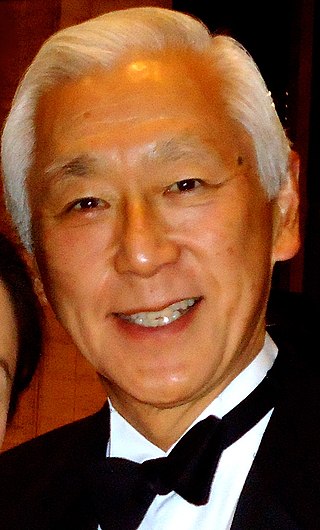
Oscar Liu-Chien Tang is a Chinese-born American businessman, financier, investor, and philanthropist. He is best known for being the co-founder of Reich & Tang, an asset management firm. Tang was elected a fellow of the American Academy of Arts and Sciences in 2005. Prior to this, he was appointed to the New York State Council on the Arts from 2000 to 2004 and the President's Committee on the Arts and Humanities from 1990 to 1993.

John Stewart Kennedy was a Scottish-born American businessman, financier and philanthropist. He was a member of the Jekyll Island Club on Jekyll Island, Georgia along with J.P. Morgan and William Rockefeller among others.

Glenn David Lowry is an American art historian and director of the Museum of Modern Art (MoMA) in New York City since 1995. His initiatives there include strengthening MoMA's contemporary art program, significantly developing the collection holdings in all media, and guiding two major campaigns for the renovation, expansion, and endowment of the museum. He has lectured and written extensively in support of contemporary art and artists and the role of museums in society, among other topics.
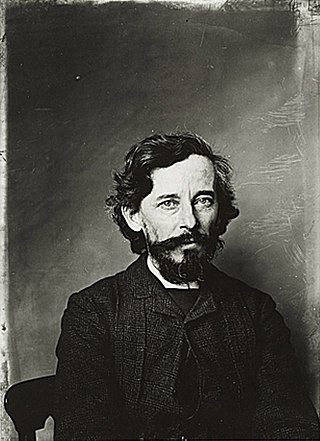
Xanthus Russell Smith was an American marine painter best known for his illustrations of the American Civil War.
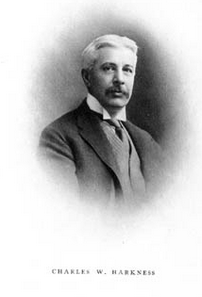
Charles William Harkness was a son of Stephen V. Harkness and his second wife, the former Anna M. Richardson.

William Lamon Harkness was an American businessman and inheritor of a large share of Standard Oil.

Oliver Burr Jennings was an American businessman and one of the original stockholders in Standard Oil.

The Edward S. Harkness House is a Modern Renaissance–style mansion at the northeastern corner of Fifth Avenue and 75th Street on the Upper East Side of Manhattan in New York City, United States. Built between 1907 and 1909, it was designed by James Gamble Rogers for the philanthropist Edward Harkness and his wife Mary Harkness. The mansion, which has been the Commonwealth Fund's headquarters since 1952, is a New York City designated landmark.

Albert Morton Lythgoe was an American archaeologist and Egyptologist. He is best known for his work for the New York Metropolitan Museum of Art, and for the support he gave to the excavation of Tutankhamun's tomb, he releasing several key Metropolitan Museum staff to assist Howard Carter.

William Adams Brown was an American minister, professor and philanthropist.

